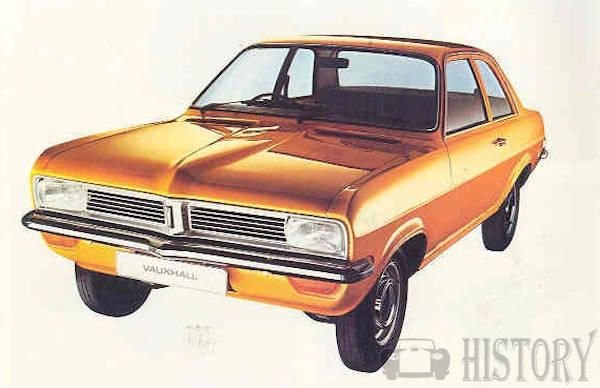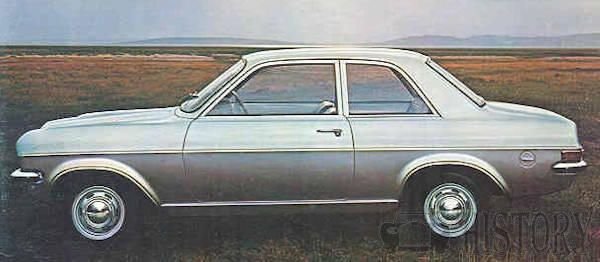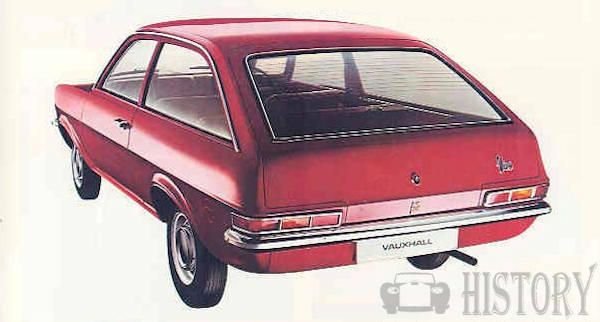Vauxhall Viva HC
| 1970–1979 | |
|---|---|
 |
|
| Overview | |
| Manufacturer | Vauxhall Motors |
| Also called | Firenza, Magnum |
| Production | 1970–1979 640,863 produced |
| Body and chassis | |
| Body style | 2-door saloon 2-door coupé 4-door saloon 3-door estate |
| Related | Vauxhall Magnum Vauxhall Firenza Chevrolet Firenza |
| Powertrain | |
| Engine | 1159 cc OHV I4 1256 cc OHV I4 1759 cc OHC I4 2279 cc OHC I4 |
| Transmission | 4-speed manual GM-Automatic (with 1,759 & 2,279 cc engines: Viva SL only) |
| Dimensions | |
| Wheelbase | 97 in (2,464 mm) |
| Length | 162.875 in (4,137 mm) |
| Width | 64.75 in (1,645 mm) |
| Height | 53 in (1,346 mm) |
| Curb weight | 1,837 lb (833 kg) - 2,237 lb (1,015 kg) |
| Chronology | |
| Predecessor | HB Viva |
| Successor | Vauxhall Chevette Vauxhall Astra |
The Viva HC (1970–1979) was mechanically the same as the HB but had more modern styling and greater interior space due to redesigned seating and positioning of bulkheads. It offered 2- and 4-door saloons and a fastback estate with the choice of either standard 1159 cc, 90 tuned 1159 cc or 1600 cc overhead cam power. No 2.0 GT version was offered with the new range, although the 2.0 became the sole engine offering for Canada, where the HC became the Firenza, marketed by Pontiac/Buick dealers without the Vauxhall name. The cloned Envoy Epic was dropped as Chevrolet dealers now carried the domestic Chevrolet Vega. The HC was pulled from the Canadian market after two model years amidst consumer anger over corrosion and reliability issues. A class action lawsuit launched against General Motors of Canada by dissatisfied owners was not settled until the early 1980s.
The American influence was still obvious on the design, with narrow horizontal rear lamp clusters, flat dashboard with a "letterbox" style speedometer, and a pronounced mid bonnet hump that was echoed in the front bumper.
A coupe version called the Firenza was introduced in spring 1971 to compete with the Ford Capri and forthcoming Morris Marina Coupe. It was available in deluxe and SL forms, with the latter sporting four headlights and finally resurrecting the missing 2.0 twin carb engine from the HB Viva GT.
The basic 1159 cc engine was enlarged to 1256 cc in late 1971 and with this the 90 version was removed from the line-up.
The overhead cam engines were upgraded in spring 1972, the 1.6 becoming a 1.8 (1759 cc) and the 2.0 (1975 cc) twin carb became a 2.3 (2279 cc). At this time, the Viva 2300 SL and Firenza Sport SL did away with the letter-box speedometer and substituted an attractive seven dial instrument pack. Firenza SLs had a two round dial pack, though all other Vivas and Firenzas stuck with the original presentation.
Viva Series
1 Viva E 2-door Saloon
2 Viva E 4-door Saloon
3 Viva 1300 L 2-door Saloon
4 Viva 1300 L 4-door Saloon
5 Viva 1300 L Estate Car
6 Viva 1300 GIS 2-door Saloon
7 Viva 1300 GLS 4-door Saloon
8 Viva 1300 GLS Estate Car
In September 1973, the Viva range was divided, the entry 1256 cc models staying as Vivas, with optional 1.8 power if automatic transmission was chosen.
The 1.8 and 2.3 L models took on more luxurious trim and were rebadged as the Magnum. At the same time, the Firenza coupe was given a radical makeover with an aerodynamic nose and beefed up 2.3 L twin carb engine mated to a ZF five-speed gearbox, turning it into the HP (High Performance) Firenza.
The Viva was again revised in 1975, with trim levels becoming the E (for Economy), L and SL. The E was Vauxhall's answer to the Ford Popular and was first offered as a promotional edition two-door coupe using surplus Firenza body shells, before becoming a permanent Viva model in two-door saloon form. It was the only Viva to still have the strip speedometer after this as the L and SL adopted the Firenza SL's two round dial set up. As of the fall of 1975 the 1800 engine was also upgraded, increasing power from 77 to 88 hp (57 to 66 kW; 78 to 89 PS).

For 1977, the SL was replaced by the GLS, essentially marrying the plusher Magnum trim and equipment with the base 1,256 pushrod ohv engine. These models all had the full seven dial instrument panel, velour seating and Rostyle wheels, among many other upgrades.
OPTIONAL ACCESSORIES 155 SR x 13 tyres and heated rear Window (only for Viva E); metallic spray (except for Viva E); vinyl roof (only for GLS saloons). Automatic transmission, hydraulic torque converter and planetary gears with 3 ratios.
In New Zealand, the Viva was originally built in two- or four-door sedan and wagon/van form with 1159cc and 1256cc engines. A batch of 1.8-litre models, some with automatic transmission, was imported from the UK in 1973/4 when the government temporarily relaxed import restrictions on built-up cars as local CKD plants could not meet demand. The 1.8-litre engine and automatic transmission later were added to CKD assembly and the entire range was renamed Magnum in 1976. This had the four headlight nose and improved trim and equipment, such as a two-dial instrument pack and heated rear window, in a bid to overcome the Viva's basic car image - its original place in the GM range now taken by a newly launched, wide range of locally-made 1.3-litre Chevettes - and slowing sales. The Magnum also had an 1800 engine option, often teamed with automatic transmission.
A version of the Viva HC, called the Chevrolet Firenza, was produced in South Africa, where it offered the British 1.3 or an Opel 1.9 L engine. The UK Firenza coupe was also offered in South Africa, with a special batch even having the small-block Chevrolet V8 stuffed in to make for a veritable wolf in sheep's clothing. S Africa also saw a three-door hatch developed off the Viva rather than taking on the then new Chevette/Kadett City (see next paragraph).
Viva production was scaled down after the launch of the Chevette in spring 1975. Originally a 3-door hatchback, the Chevette offered 2- and 4-door saloons and a 3-door estate in 1976 that all usurped the Viva's position as Vauxhall's small car entry.

The Chevette hatch was also sold as the Opel Kadett City, but the Viva remained on sale until the later part of 1979.
It was effectively replaced by the new Vauxhall Astra, a variant of the front-wheel-drive Opel Kadett. By that time it was feeling very dated in comparison with more modern rivals like the Volkswagen Golf. Production ceased at a time when European manufacturers were making the transition from rear-wheel-drive saloons to front-wheel-drive hatchbacks in the family car market.
The passing of the Viva marked a significant moment for Vauxhall, as it was the last car to be completely designed by the Luton-based company. All future Vauxhalls would be simply badge-engineered Opels, or in the case of the 2004 Vauxhall Monaro, a rebadged Holden.
The domestic market launch of the Viva HC coincided with one of the UK's periodic surges of debt fueled economic growth, and the latest Viva became Vauxhall's fastest selling new model of all time, chalking up its first 100,000 units in just 71⁄2 months.Total HC sales ran to about 640,000 units, making combined Viva production top the 1.5 million mark. The millionth Viva, a gold HC, was driven off the production line by a national politician amid much celebration on 20 July 1971. Although most Vivas were produced at Vauxhall's Ellesmere Port plant in northern England, the company's production lines were by the standards of the time flexible, and the millionth car was a product of the Luton factory.However, within seconds of the Millionth Viva's completion at Luton, Ellesmere Port celebrated what was described - over-optimistically as matters turned out - as the first Viva of the second million.
There's an interesting car (at least because of its origins) produced from 1970 to 1972, based on Vauxhall Vivas by General Motors in Uruguay. They were called Grumett, and came only in double-cab, two-door pick-up models, with a 1100 cc engine. The body was fiberglass...some original Vauxhalls were imported to serve as molds. Mechanicals were either Vauxhall or Opel, depending on batch. GM Uruguay also produced a car called the Indiana, also fiberglass, to all intents and purposes a Viva HC estate, but with a slightly shorter wheelbase and narrower track... which produced a very strange effect, not very nice. Apparently the cars were fully based on Opel Kadett mechanicals. The cars were relatively reliable, as fiberglass wouldn't corrode, even though they had steel tubing as an internal "chassis".

Technical
-
Vauxhall Viva HC Technical details and specifications (1970-1979)
1.8L (88 hp)
ENGINE 107.3 cu in. 1,759 cc
compression ratio: 8.5:1
5 crankshaft bearings
valves: overhead, in line: camshafts: 1, overhead
1 Zenith 36 IV down. draught single barrel carburettor
cooling system: 14 Imp pt. 16.9 US pt, 8 1.STEERING
rack-and-pinion
turns lock to lock: 3.16.BRAKES
front disc (diameter 8.50 in, 33.5 cm), self-adjusting rear drum, serveo; swept area: front 154.6 sq in, 997 sq cm, rear 62.9 sq in, 405 sq cm, total 217.5 sq in, 1,402sq cm.
ELECTRICAL EQUIPMENT
12 V; 33 Ah battery
336 W alternator
AC Delco distributor
2 headlamps (4 on GLS)CHASSIS
front suspension: independent, wishbones. coil springs, telescopic dampers
rear: rigid axle, lower radius arms, upper oblique radius arms, coil springs, telescopic dampers.DIMENSIONS
wheel base: 97 in, 246 cm
tracks: 51.80 in, 13.2 cm front, 51.50 in, 131 cm rear
length: 162.90 in, 414 cm
width: 64.70 in, 164 cm
height: 53,20 in, 135 cm
ground clearance: 5.40 in, 13.7 cm
turning circle (between walls): 34.1 ft, 10.4 m
fuel tank: 8 imp gal, 9.5 US galWEIGHT
weight: E 20. and 1300 L 2-dr. 1,916 lb. 869 kg - E 4-dr. and 1300 L 4-dr. 1,951 1b, 885 kg - 1300 L Estate car 2,019 1b, 916 kg - 1300 GCS 2-dr. 1,899 1b, 861 kg - 1300 GLS 4-dr. 2,002
1b, 908 kg - 1300 GLS Estate car 2,068 1b, 938 kg
Service
-
Vauxhall Viva HC Service instructions (1970-1979)
1.8L (88 hp)
fuel: 98 oct petrol
oil: engine 4.9 imp pt. 5.9 US pt. 2.8 1, SAE IOW-30, change every 6.000 miles, 9.700 km
gearbox 0.9 imp pt. 1.1 US pt, 0.5 1. SAE 90. change every 6 months
final drive 1.2 imp pt, 1.5 US pt. 0.7 1, SAE 90, no change recommended
greasing: every 6 months, 4 points
tappet clearances: inlet 0.008 in, 0.20 mm, exhaust 0.008 in, 0.20 mm
valve timing: 39° 73° 71° 41°
tyre pressure: front 24 psi, 1.7 atm, rear 24 psi, 1.7 atm.
